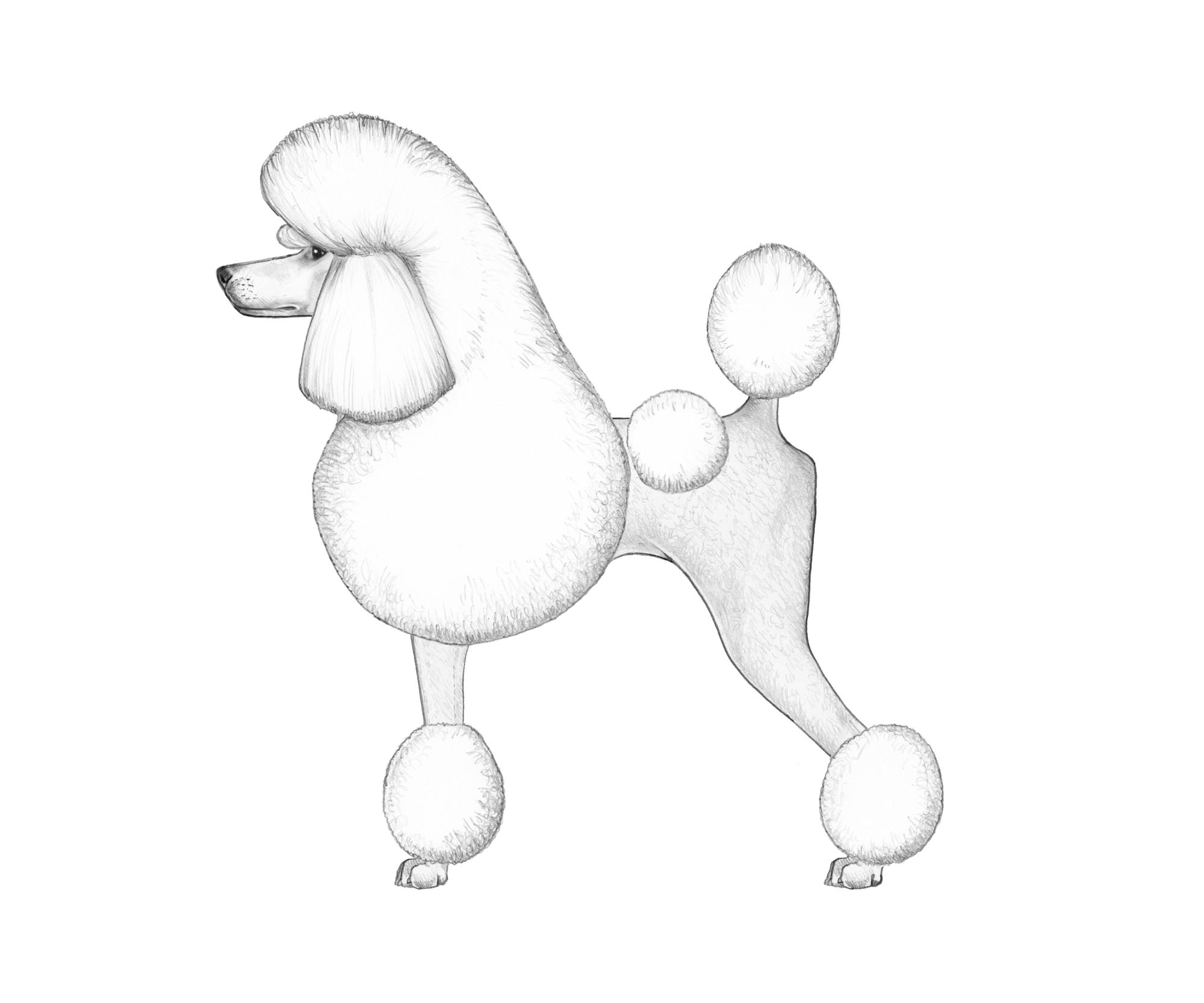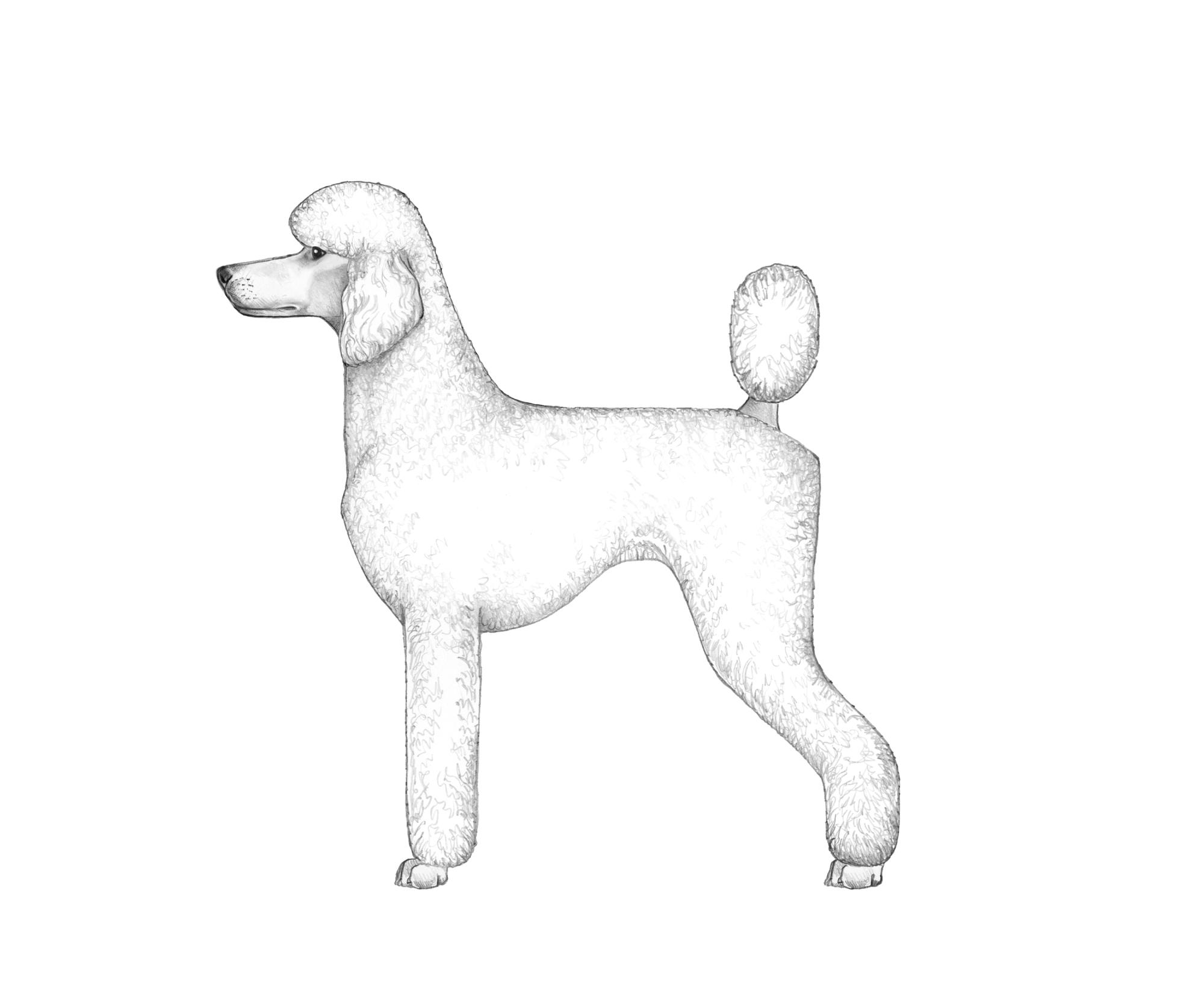Poodle
Companion Dog Group
The goals and purposes of this breed standard include: to furnish guidelines for breeders who wish to maintain the quality of their breed and to improve it; to advance this breed to a state of similarity throughout the world; and to act as a guide for judges.
Breeders and judges have the responsibility to avoid any conditions or exaggerations that are detrimental to the health, welfare, essence and soundness of this breed, and must take the responsibility to see that these are not perpetuated.
Any departure from the following should be considered a fault, and the seriousness with which the fault should be regarded should be in exact proportion to its degree and its effect upon the health and welfare of the dog and on the dogs ability to perform its traditional work.
Please Note: For Conformation exhibition purposes only, the solid-colored dogs and multi-colored dogs are shown separately. They are not actually separate breeds.
HISTORY
The Miniature and Toy Poodles were probably developed by crossing small Standard Poodles with Maltese and Havanese to bring down the size. While the Standard Poodle was first developed as a hunting dog, the Miniature and Toy varieties were strictly companion dogs, popular in the French court from the reign of Louis XIV through that of Louis XVI. Miniature and Toy Poodles appear in many 17th century paintings. These dogs were also popular with circus performers and clowns from as early as 1700 through the late 1800s. Poodles were first brought to the United States at the end of the 19th century, but the breed did not become popular until after World War II. By the mid 1950s, the Poodle was the most popular breed in the United States, a position held for over 20 years. Today the Poodle is divided into two breeds
- The Standard Poodle, which serves primarily as a Gun dog and companion animal
- The Poodle, composed of the Miniature and Toy varieties, and which serves primarily as companion breed.
The standards of the two breeds are essentially identical but for size.
The Poodle was recognized by United Kennel Club in 1914. The Poodle was divided into two breeds, Standard Poodle and Poodle, on January 1, 2000.
GENERAL APPEARANCE
The Poodle is a medium-sized, squarely built dog with a distinctive harsh curly coat that may be presented in any of several traditional Poodle clips or corded. The ears are long, drop, and densely feathered. The tail is normally docked, set high, and carried erect. The length of body (sternum to point of buttocks) is equal to the height (withers to ground). The Poodle carries himself with an air of dignity and pride.
CHARACTERISTICS
The Poodles most readily identifiable characteristic is its harsh, dense coat, which is presented in various trims or corded. Another essential characteristic is proper temperament. The breed is noted for its high intelligence, trainability, and sense of humor. Poodles are highly social and require human companionship and regular, close interaction with family members. Because of their great intelligence and the joy they take in human companionship, Poodles excel in performance events of all sorts. They are extremely affectionate with children.
HEAD
The head is proportionate to the size of the dog. When viewed from the side, the skull and muzzle are roughly parallel to one another and joined by a slight but definite stop.
SKULL - The skull is long and moderately rounded on top. Cheeks are clean and flat.
MUZZLE - In profile, the muzzle is straight and roughly equal in length to the length of the skull, measured from stop to occiput. The muzzle is fine with a slight chiseling under the eyes, but with sufficient depth of underjaw to prevent snipiness. Lips are tight with black or liver pigment appropriate to coat color.
Serious Faults: Incomplete lip pigment or of wrong color for color of coat; weak underjaw.
TEETH - The Poodle has a complete set of evenly spaced, white teeth meeting in a scissors bite.
Serious Faults: Overshot, undershot, wry mouth.
NOSE - Nose leather is liver for dogs with brown, caf-au-lait, or silver beige coat color. Dogs with coats of all other colors must have black pigment, except that dogs with apricot or red coats may have liver nose pigment but it is not preferred.
Serious Faults: Incomplete nose pigment or of wrong color for color of coat.
EYES - Eyes are oval in shape and set sufficiently wide apart to give an alert, intelligent expression. Eyes are dark brown in dogs with black pigment and range from dark brown to dark amber for dogs with liver pigment.
Serious Faults: Round, protruding, large or very light eyes; incorrect eye and eye rim colors for color of coat; incomplete eye rim pigment.
Disqualifications: Any variation of blue eyes, including flecks and marbling.
EARS - Ears are drop with long, wide, densely-feathered ear leather. Ears are set at or slightly below eye level and hang close to the head.
NECK
The neck is of sufficient length and strength to permit the head to be carried high when standing or moving. The neck blends smoothly into well-laid-back shoulders. The skin on the neck and throat is tight.
Serious Fault: Ewe neck
FOREQUARTERS
Shoulders are smoothly muscled. The shoulder blades are long and well laid back. The upper arm appears to be equal in length to that of the shoulder blade and joins it at an apparent right angle. Elbows are close to the body. The forelegs are straight with bone and muscle proportionate to the size of the dog. Pasterns are strong and slightly sloping. Viewed from the front, the forelegs are parallel. Viewed from the side, the point of elbow is directly below the withers.
Serious Fault: Upright shoulders.
BODY
A properly proportioned Poodle is square, with the length of body (measured from prosternum to point of buttocks) equal to height (measured from the withers to the ground). The length of the front leg (measured from point of elbow to the ground) is just slightly longer than half the dogs height. The line of the back drops off almost imperceptibly behind the withers and is then level. The loin is short, broad, and muscular with moderate tuck-up. The ribs extend well back and are well sprung out from the spine, then curving down and inward to form a deep body. The brisket extends to the elbow. Viewed from the front, the chest is well filled and moderately wide.
HINDQUARTERS
Hindquarters are muscular and with broad second thighs. The angulation of the hindquarters is in balance with the angulation of the forequarters. The stifles are well bent, and the hocks are well let down. When the dog is standing, the short, strong rear pasterns are perpendicular to the ground and, viewed from the rear, parallel to each other. In profile, the croup is nearly flat.
FEET
The feet are relatively small, oval in shape and compact with well-arched toes and thick, elastic pads. Feet do not turn in or out. Nails are short and dark or self-colored. Dewclaws may be removed.
Serious Fault: Thin pads, splay foot.
TAIL
The tail is straight, set high, and normally docked to a length proportionate to the size of the dog. Whether standing or moving, the tail is carried erect.
Serious Faults: Low tail set, tail curled or carried over the back.
COLOR
Coat colors in Poodles include the following colors: black, blue, gray, silver, red, apricot, cream, white, brown, caf-au-lait, and silver beige.
Dogs whose coats include the brown shades may have dark amber eyes; liver noses, eye rims and lips; and dark nails. Dogs with apricot or red coat color may have this combination of eye, pigment, and nail color as well but it is not desirable. All others must have very dark eyes; black noses, eye rims and lips; and black or self-colored nails. Coat color is solid and even. Clear colors are preferred but natural variations in the shading of the coat are not to be considered a fault.
Dogs whose coats are of the progressive graying colors, such as blue, silver, caf-au-lait and silver beige may present with a coat that includes hair in various stages of clearing and may appear to have multiple shades until fully cleared. These colors may also include darker pigmented hair in areas where the skin was damaged, the hair grew back, and will need to clear again. While not due to progressive greying, apricot and cream will also sometimes clear unevenly and may maintain a darker pigment on the ears.
In cases where there are only a few barely noticeable white hairs, on the chin, a chest spot, or the toes, then exhibitor may show in Poodles rather than multi-colored Poodles.
Disqualification: Any color other than described above; merle coloring. Albinism.
COAT
The Poodle has harsh, dense, curly coat. For conformation exhibition, the coat may be presented naturally, corded, or in one of the clips described below. Quality is never to be sacrificed in favor of grooming skill or the type of clip in which a dog is presented.
Corded In all clips, cords are tight and of even diameter but varying lengths. Cords may be longer on the mane, body coat, head and ears; shorter on puffs, bracelets and pompons.
Clips - In all clips described below, the hair on the topskull may be left free or held in place by elastic bands, which may not be used elsewhere in the coat. There is no limit to the number of bands used, but they may not go past the occiput. SEE PDF FOR CLIP ILLUSTRATIONS AND DESCRIPTIONS.
HEIGHT
Miniature - Over 10 inches up to 15 inches, measured at the withers.
Toy - 10 inches or under, measured at the withers.
Within each individual variety, the judge shall favor the smaller dog when all other factors are equal, including
balance and proportion.
Serious Faults: A Miniature Poodle over 15 inches or 10 inches and under; a Toy Poodle over 10 inches.
GAIT
When trotting, the gait is effortless, smooth, powerful and well coordinated, showing good reach in front and drive behind. Action is light and springy with head and tail carried up.
DISQUALIFICATIONS
(A dog with a Disqualification must not be considered for placement in a conformation event, and must be reported to UKC.)
Unilateral or bilateral cryptorchid.
Viciousness or extreme shyness.
Albinism.
Any color other than described above.
Merle coloring.
Blue eyes, or any variation of, including flecks and marbling.
The docking of tails and cropping of ears in America is legal and remains a personal choice. However, as an international registry, the United Kennel Club is aware that the practices of cropping and docking have been forbidden in some countries. Considering these developments, the United Kennel Club feels that no dog in any UKC event, including conformation, shall be penalized for a full tail or natural ears.
Please Note: In UKC Conformation Shows, this breed is shown by variety in this order Toy, Miniature.

Continental clip

Sporting clip
Download the coat clips document (PDF) 1 page
Looking for a Dog?
Find a dog that will fit your family.
Note: The breeders on this list are not endorsed by UKC.
Revised January 1, 2025
©Copyright 1991, United Kennel Club
